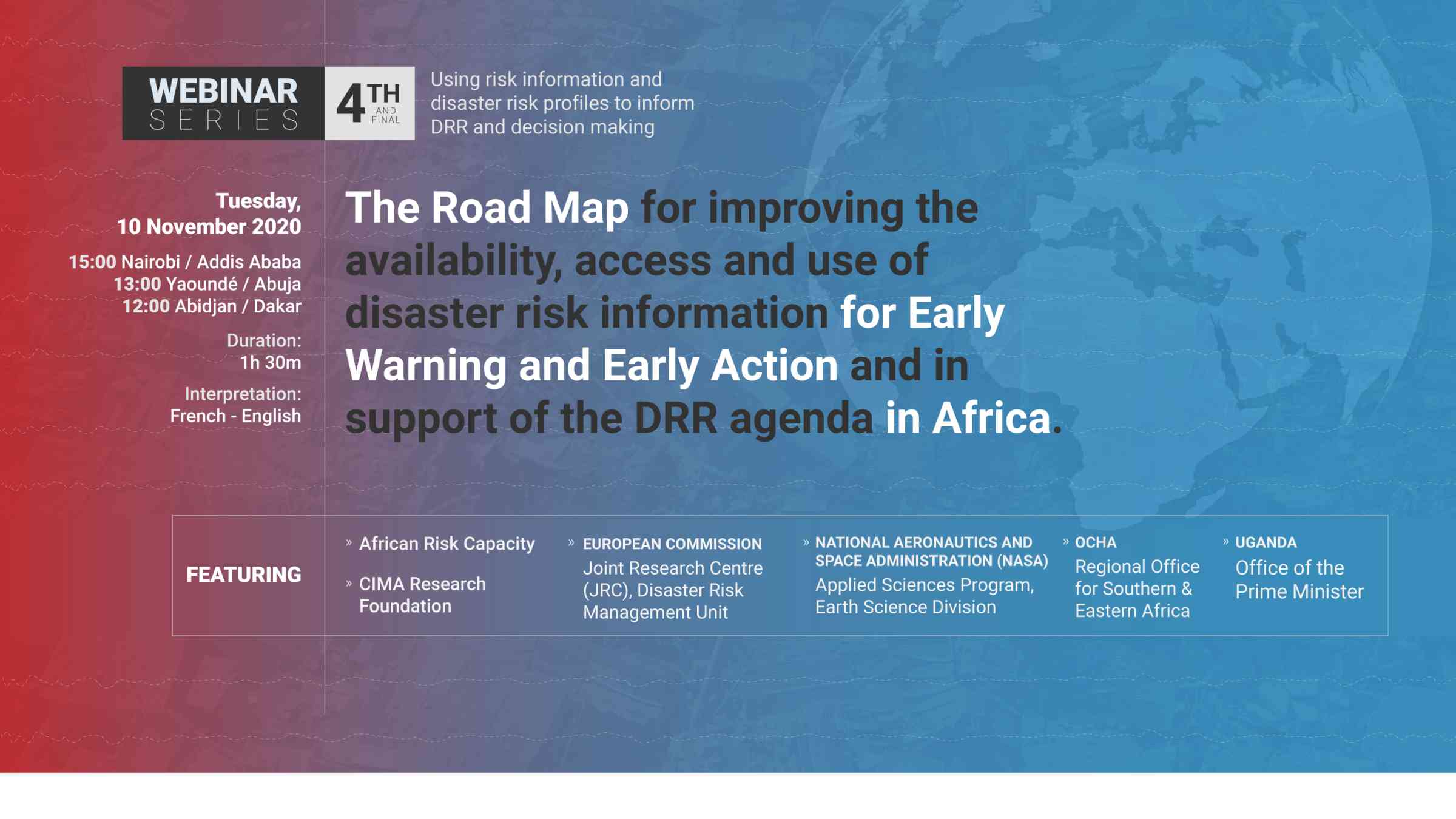4th Webinar: Using risk information and disaster risk profiles to inform DRR and decision making: The Africa Road Map

UNDRR, African Union Commission, and CIMA webinar series:
Using risk information and disaster risk profiles to inform DRR and decision making: the road map for improving the availability, access and use of disaster risk information for Early Warning and Early Action and in support of the DRR agenda in Africa.
4th and final webinar:
The methodology of quantitative risk assessment for a sub-national, national and regional level assessment
Date 10 November 2020
15:00 Nairobi / Addis Ababa | 13:00 Yaoundé / Abuja | 12:00 Abidjan / Dakar |
Duration: 1h 30 min / Interpretation: French-English
Registration link:
https://undrr.zoom.us/webinar/register/WN_ZJ7zpMaqT82rJDUJpCkthg
Background:
Risk information is produced and disseminated through diverse products, which target different audiences. In the framework of “Building Disaster Resilience to Natural Hazards in Sub-Saharan African Regions, Countries and Communities” Programme funded by the European Union, UNDRR, CIMA Research Foundation and the National Disaster Management Authorities of 16 African countries, developed quantitative country-level disaster risk profiles for floods and droughts, using the probabilistic approach, combined with DRR-sensitive national budget analysis, to inform holistic, inclusive and actionable strategies for disaster risk reduction, climate change adaptation and sustainable development.1 A Guideline for the use of the risk profiles was developed, outlining select possible applications of probabilistic risk assessments. Furthermore, the programme produced a Road Map for Improving the Availability, Access and Use of Disaster Risk Information for Early Warning and Early Action, including in the Context of Transboundary Risk Management. The road map identified activities and practical recommendations at the continental, regional, national levels, focusing on the African Union Commission (AUC), the Regional Economic Communities (RECs) and four countries - Angola, Zambia, UR Tanzania, and Ethiopia. The road map includes a particular application of the risk profiles for strengthening impact-based Early Warning Systems. Among the objectives were the need to enhance the use of risk information and the institutional capacity for data exchange and for coordination among national, regional and continental actors, with the view of strengthening national and transborder disaster risk management.
The overall objective of the webinar series is to reflect on how the risk profiles and the Road map can further support the DRR agenda on the continent. The webinar series will seek to deliver on the following:
- Critically assess the priorities set out in the road map to inform key short-term and midterm investments required for the development and improvement of a harmonized system of Early Warning for Early Action and transboundary risk management interconnecting the continental, regional and national levels of disaster risk governance;
- Consider the advantages of a continental road map aiming to foster an EWS with a consistent approach across the continent;
- Assess the advantages and the challenges of risk profiles based on probabilistic risk assessments;
- Further elaborate possibilities for quantitative risk profiles to inform the DRR Agenda at the national, and eventually at the regional and continental scale.
The aim of the fourth webinar is to:
- Present and discuss examples of methodologies for quantitative disaster risk assessments developed and used to support risk-informed decision making;
- Reflect on the methodological requirements for diverse risk assessments to allow for comparability of results and complementarity in multi-hazard assessment and in support trans-boundary risk management
Outcomes of the virtual session:
- Participants have a better understanding of the methodological choices made in the design of a disaster risk assessment;
- Participants can appreciate the challenges and opportunities in producing risk information for trans-boundary risk management
Speakers invited to contribute to the webinar:
- Uganda, Office of the Prime Minister – on the recent production of the Risk Atlas;
- African Risk Capacity (ARC) – on the comparability of results in ARC’s work across countries within the insurance pool;
- OCHA, Regional Office for Southern & Eastern Africa – on the requirements for quantitative estimation of damage and coping capacity to serve humanitarian operations;
- CIMA Research Foundation – on probabilistic RA at the regional, national and subnational level and how methodological choices allow for targeted or more general applications for disaster risk management. Also reflecting on whether there is a methodology that can fit all the possible risk assessment applications or is it better to use distinct methodologies for each specific application;
- National Aeronautics and Space Administration (NASA), Applied Sciences Program, Earth Science Division – speaking as a member of the Global Assessment Framework (GRAF) community on systemic risk assessment about desired linkages and complementarity across diverse methods for risk assessment;
- European Commission, Joint Research Centre (JRC), Disaster Risk Management Unit – on the findings and the recommendation from the recent report on National Risk Assessment for Disaster Risk Management, which acknowledges the variety of different assessment methodologies and processes across EU countries, but seeks to suggest approaches to enable comparison of results and replication in order to identify common risks and to coordinate strategies and resources to face them.
Target audience:
- Representatives of national disaster management authorities, meteorological services, water and irrigation and other relevant stakeholders involved in early warning;
- Representatives working on DRR from the Regional Economic Communities in Sub-Saharan Africa (ECOWAS, ECCAS, IGAD, SADC) and the African Union Commission;
- Representatives from UN agencies (FAO, Un-Habitat, UNECA, UN Women, OCHA, UNDP, UNICEF, UNESCO etc.) and international organizations (e.g. IFRC) and donors;
- Representatives of NGO’s and civil society;
- Representatives of academia and the scientific community.
References:
16 country level probabilistic risk profiles for flood and drought (2019):
http://riskprofilesundrr.org/riskprofiles/countries.html
Guidance Note on Using the Probabilistic Country Risk Profiles for Disaster Risk Management:
https://www.undrr.org/publication/guidance-note-using-probabilistic-country-risk-profiles-disaster-risk-management
Africa Road Map for Improving the Availability, Access and Use of Disaster Risk Information for Early Warning and Early Action, including in the Context of Transboundary Risk Management:
https://www.undrr.org/publication/africa-road-map-improving-availability-access-and-use-disaster-risk-information-early
Also featured on
Is this page useful?
Yes No Report an issue on this pageThank you. If you have 2 minutes, we would benefit from additional feedback (link opens in a new window).